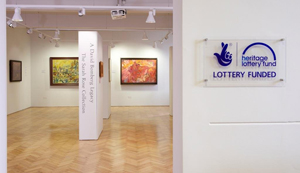A new gallery is opening within London South Bank University. Mary Paterson talks us through the process that led to its arrival

It took three short months to make the dramatic transformation from teaching space to gallery space. Last November there were two dark classrooms with low ceilings, old carpet and traces of blu-tack stuck to the walls. Now, the rooms have been knocked through, the ceiling has been raised, the floor has been polished and the new Borough Road Gallery has arrived.
But it’s nearly four years since London South Bank University (LSBU) received ‘A David Bomberg Legacy: The Sarah Rose Collection’ – a gift of almost 200 paintings, drawings and prints from private collector Sarah Rose. And, after years of planning, it’s been eight months since the Heritage Lottery Fund awarded LSBU nearly £250,000 for an ambitious two year plan that included building the Borough Road Gallery, curating four exhibitions, producing a digital archive, devising a volunteering programme, and forming partnerships with local schools and adult education colleges as well, of course, as partnerships within the different departments of the University itself.
The transformation between teaching space and viewing space is not just material. It represents the project of the Borough Road Gallery as a whole: to create a public facing gallery inside an institution which was originally designed for a different purpose.
LSBU’s focus is on creating professional opportunity for all who can benefit. It places a strong emphasis on recognising the potential of students from a range of academic backgrounds, and on helping its students into employment. It runs a successful BA in Arts Management, for example, that has an excellent record of helping graduates to get on the arts sector job ladder, without the unfortunate fate of low paid (or no paid) first positions.
But running a small gallery is a very different endeavour to running a large university. The art world does not conform to the academic calendar and this project in particular requires a fast turnaround time – which is incompatible with the policies and procedures of an organisation as large as LSBU.
There have been some small teething problems as the institution and the gallery get to know one another. A few weeks ago, for example, I tried to order some supplies for wrapping artwork. Instead of high quality paper tissue, I found myself in receipt of something much more common around here: an industrial sized roll of toilet tissue. And when we had to move a collection of paintings from the entrance hall to a temporary store room, it took a fortnight to find the people competently risk-assessed and experienced to carry them up a flight of stairs.
This tendency for finding the long way round is compounded by what I call “the curse of capital works”. As someone with a background in performance and participatory arts, I am used to a ‘try it and see’ mentality – let the games begin, we can always change things later. That approach is not very useful when you’re dealing with structural changes to a building. You can’t easily rethink the height of a ceiling or the colour of the walls. And that means it’s easy to get caught in a trap of excessive cautiousness. Is this the right colour? Is this really the right colour?
There are of course advantages to working with an institution like LSBU. After years of shoestring budgets, it’s a revelation to be able to call on a dedicated press team. The project also benefits from the skills of three conscientious Arts Management students, who offer practical help and no-nonsense opinions rolled into one. And it’s a testament to the University’s commitment to this project that the entrance to the Borough Road building has been renovated in time for the gallery’s opening in June.
The moment the gallery opens its doors will be the moment all our hard work is put to the test. It will also be when the ideologies of the University and the gallery truly meet. Ultimately we’re both interested in the same thing: what the public thinks.




